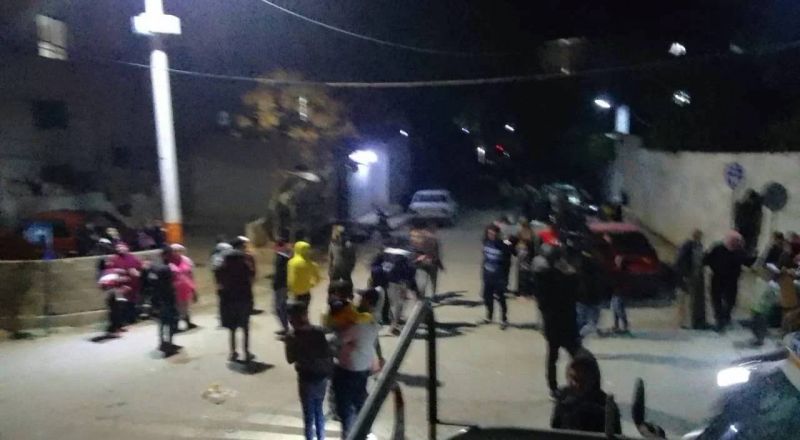
A scene of panic observed in Akkar after the earthquake of Feb. 20. (Credit: Michel Hallak/OLJ)
Since the Feb. 6 earthquake, even the slightest tremors have triggered panic in various parts of Lebanon.
Most aftershocks took place near the quake’s epicenter but tremors were still felt in Lebanon. Images of terrified Lebanese citizens gathered on the streets in the middle of the night circulated on Monday and Tuesday, after the reverberations of a 6.3 magnitude tremor that hit Anatolia were felt in Lebanon.
Soon after, pseudo-scientific earthquake theories circulated on social and local media, which fueled misinformation. The internet was filled with unfounded claims, from false predictions of future earthquakes, to theories blaming the planetary alignment’s effect on the earth and “unidentified flying objects” spotted at the time of the earthquake.
“The success of fake news should not be attributed to those who spread it, but rather to the public who, already vulnerable and under high stress due to the economic crisis, seeks the most frightening scenarios because it is naturally more receptive to alarming news,” said Naji Kehdy, professor of hydrogeology and geology at the Lebanese University.
Overwhelmed by the public panic, Kehdy took to Facebook to deconstruct the myths and bring science back to the table.
“Some people, who have never been able to publish their theories in scientific journals, use social media to spread their ideas,” he said.
Many people on the internet are imitating the Dutch man who attributed the earthquake to planetary movements (and gained overnight Twitter fame for his fluke earthquake prediction), said Kehdy.
But what the expert fear most is the harmful effect of panic. “Rushing down the stairs and leaving the building with a suitcase in hand doesn’t make sense when it comes to earthquakes,” Kehdy said.
“In case of a very powerful earthquake, there would be no time to do this, and it is better to take simpler and more effective measures, such as taking refuge under a table or behind a fridge, for example, to avoid being injured by a moving object and to have a protective zone. In case of a much weaker tremor, leaving the home is a useless precaution and would even promote chaos, which in turn could be deadly,” he said.
“There is no point in waiting for the earthquake, science still cannot predict such an event or its magnitude,” Kehdy added.
Tremors ‘within the norm’
The best way to ease mass anxiety is to return to science. According to Kehdy, this involves providing the public with a scientific explanation of what happened in Turkey and Syria and its link to Lebanon.
“In Turkey, there is a meeting point of three tectonic plates, the Arabian Plate, the Eurasian Plate and the Anatolian Plate at the epicenter of the initial 7.8-degree earthquake on Feb. 6,” he said. “The pressure the Arabian Plate placed on the others, having reached its peak, caused the big earthquake.”
According to Kehdy, the events that followed the initial earthquake of Feb. 6 are completely normal. He cited that a similar situation unfolded in the aftermath of the 8.2 magnitude earthquake that shook Chile in 2014.
“The series of aftershocks can continue for up to a month after the initial quake,” he added. “These aftershocks, even if strong, have a lower magnitude than the first quake. As the pressure between the tectonic plates continues, the earth releases pressure on the various fault lines in the contact zone in this way. It is sort of reassuring news since the multiplication of these small events technically keeps at bay the specter of a more violent tremor.”
Lebanon is on the Yammouneh fault line and according to experts, the greatest quake to affect the country in the past 100 years had a magnitude of 6 and occurred in 1956.
The tremors felt in recent days, including the 4.2 magnitude tremor registered a few kilometers from Hermel on Feb. 8, were “within the norm” and are typical after such a large quake.
“Keeping in mind that science still does not allow us to predict earthquakes, we can estimate that a series of small tremors allow the gradual release of the energy contained in the earth and coming from the pressure between the plates, and would reduce the possibility of a larger earthquake,” said Kehdy. “In other words, what is causing panic today may be something reassuring.”
Kehdy stressed that it is not possible to “wait for the earthquake,” because geological time cannot be compared to human time.
This article was originally published in French in L'Orient-Le Jour. Translation by Joelle EL Khoury.
Most aftershocks took place near the quake’s epicenter but tremors were still felt in Lebanon. Images of terrified Lebanese citizens gathered on the streets in the middle of the night circulated on Monday and Tuesday, after the reverberations of a 6.3 magnitude tremor that hit Anatolia...